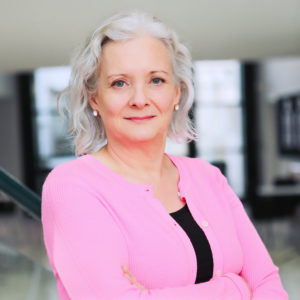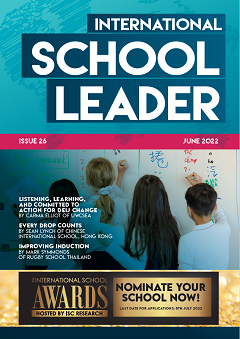American Community School of Abu Dhabi won the future-thinking innovators award at the 2021 International School Awards last January. Here Superintendent, Monique Flickinger tells their award-winning story.
Like many of my fellow heads around the world, I am always trying to find ways to incorporate teachers’ ideas into our plans for the future. Some ideas, though passionate, do not align with our strategic plans, while others hit the mark. This was the case in 2019 when our technology team had the incredible idea to transform a basement area to a hip and cool space where students could be active creators, giving them both a voice and a choice in their learning.
Imagine a classroom that has a radio station, a TV studio, a robotics arena, an animation station and a small stage for performance where students are so engaged in learning that they ignore the bell for dismissal. That became a reality with the launch of the American Community School of Abu Dhabi’s (ACS) Backstage Techttoos programme.
Giving students voice and choice
Our High School’s courses already included ten design and innovation classes, but we wanted to start this programme earlier and target students in grades 6–8. For the 2019–2020 year, we introduced the programme into the Middle School with 50% of our students making it their first choice.
The programme features a variety of topics, including robotics, coding, digital music, film-making, podcasting, pirate radio, mobile photography, digital art, animation, augmented reality, explainer videos, 3D design and print, graphic design, wearables, electronics, webcasting and video editing. That means in the same classroom, you’ll see students recording themselves playing instruments, while others are exploring creative sewing where they design and prototype interactive garments. Or you’ll find some students working on stop-frame animation with clay, while others are coding using Scratch programming language. Students can pick their own path of adventure with no deadline constraints, enabling them to move at their own pace.
Student-driven outcomes
In the first year of the programme, students were so motivated that an additional curriculum needed to be written during the term to keep up with their pace and interest. Students who completed all projects even started to develop curriculums and projects for beginners in new fields of study.
In recognition of their success, a student can earn a ‘techttoo’ to prove they fully comprehend a skill by creating projects that demonstrate their new knowledge and recording a video reflection about the skill they’ve learnt. Like badges of honour, the students proudly display small techttoos stickers on their laptops.
How technology skills support other subjects
Through the design of the Techttoo projects, students control their own learning by selecting projects that allow them to continuously improve existing skills and acquire new ones. Often, we have seen students apply their newly learned skills to other content classes. For example, a student could be inspired to animate the metamorphosis of a caterpillar to a butterfly using animation for a graded assignment for their science class or create a podcast in French to complete a group project for French class.
Flexible learning – even during a pandemic!
Aligned to the International Society of Technology in Education (ISTE) standards, the programme is both rigorous and effective. Students log into Google Classroom to review choices and select a Techttoo project. Each project, depending on the rigour, earns a student a certain number of points. For example, Level 1 projects earn 1 point, whereas Level 3 projects earn 3 points.
Because of the flipped instructional model where students view videos before beginning their projects, transitioning to remote learning during the pandemic was simple. In fact, the restraints of remote learning actually brought about some outstanding creativity from our students. In 2020, one Grade 6 student earned a Filmmaking Techttoo by completing a short horror film that was entirely done from home – from writing the script, to auditioning the cast, to directing and recording the performance, to editing and distributing the final film.
Resource hacking
While setting up a technology and innovation lab that allows students to explore more than 20 different topics sounds prohibitively expensive, we found success in creatively using existing space and resources, and then investing in a few pieces of technological equipment needed to support the programme. The classroom now thrives in a space that was mostly forgotten under the auditorium stage. And most importantly, the flipped instruction model with students pacing themselves through units means we did not have to invest in classroom sets for every unit. Sometimes students may have to wait for another student to finish their programme, but that limitation actually encourages students to explore other units they might have overlooked.
Expanding on success
Building on the programme’s success, we opened our new Elementary Innovation Lab this year with 24 new iPads, a TV studio, a podcasting studio and an animation lab. Dash and Dot, the robots, greet our young students as they adventure into the world of programming. Additionally, we’ve had to expand the offerings for our High School technology courses as students are now entering with a broader range of skills.
Now, all of our students from Kindergarten to Grade 12 have the opportunity to build the necessary digital skills to be competitive in a dynamic world. At ACS, we believe the future belongs to the creators and the innovators, and this is the place where they find their passion.
Setting up a successful modern tech programme
- Encourage a divisional leader or educator: find an inspired and passionate teacher or learning leader interested in technology.
- Front-load the instructional model and give control to the students: having instructional videos pre-recorded for a variety of topics allows students to take control of what they learn and set their own pace.
- Learn from available resources: the ACS Backstage Techttoos programme can be accessed through an open-source website platform with no password and all videos can be found on YouTube: Backstage Techttoos (for Middle School students ages 11–13) and MyTechBadges (for Elementary School students ages 5–10)
- Use social media to share your school’s success: on social media, our teachers actively share how the badge system works and the secrets to designing an innovative tech curriculum that motivates students to build skills. Check out the ACS Backstage Techttoos and MyTechBadges programmes on Instagram at @mrflicktech and on Twitter at @bradflickinger.
- Stay flexible: whether you’re adding a new unit, developing your own tech programme or evolving as a result of a pandemic, the key is to stay flexible and creative in setting up a learning environment that engages students to take control of their learning.
 By Monique Flickinger is Superintendent at American Community School of Abu Dhabi, UAE. Contact Monique on Twitter or LinkedIn
By Monique Flickinger is Superintendent at American Community School of Abu Dhabi, UAE. Contact Monique on Twitter or LinkedIn
Subscribe to ISL Magazine for more!



